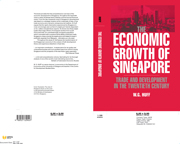Book contents
- Frontmatter
- Contents
- List of figures
- List of tables
- Preface and acknowledgements
- Abbreviations and conventions
- Geographical definitions
- Introduction
- Part One Themes and beginnings
- Part Two Development as a staple port, 1900–1939
- 3 Trade, finance and development
- 4 Ocean-going shipping, the port and regional transport
- 5 Immigration, population and employment
- 6 Rubber: boom and spread of a twentieth-century staple
- 7 Rubber, industrialization and the development of Chinese banking
- 8 Petroleum and tin: the twentieth-century boom commodity and a staple in decline
- 9 The distribution of manufactured imports
- Part Three Staple port and rapid growth, 1947–1990
- 12 Conclusion
- Appendix tables
- Bibliography
- Index
5 - Immigration, population and employment
Published online by Cambridge University Press: 22 September 2009
- Frontmatter
- Contents
- List of figures
- List of tables
- Preface and acknowledgements
- Abbreviations and conventions
- Geographical definitions
- Introduction
- Part One Themes and beginnings
- Part Two Development as a staple port, 1900–1939
- 3 Trade, finance and development
- 4 Ocean-going shipping, the port and regional transport
- 5 Immigration, population and employment
- 6 Rubber: boom and spread of a twentieth-century staple
- 7 Rubber, industrialization and the development of Chinese banking
- 8 Petroleum and tin: the twentieth-century boom commodity and a staple in decline
- 9 The distribution of manufactured imports
- Part Three Staple port and rapid growth, 1947–1990
- 12 Conclusion
- Appendix tables
- Bibliography
- Index
Summary
Immigration to British Malaya vividly illustrates that ‘There have been, in fact, in the past century three mother countries of the British Empire, i.e. the United Kingdom, India and China’. Chief among the immigrants drawn to British Malaya were the southern Chinese. The relationship of Singapore to British Malayan immigration was threefold. First, immigrants produced and consumed commodities in which Singapore traded. Malaya's staple industries were almost entirely developed with immigrant labour, and their impact on Singapore is a central concern of this study. Second, a substantial part of immigration was through Singapore. It served as the main entry and exit point for Chinese immigrants. Flows of immigration, and the shipping and labour market services consequent on them, are discussed in section I of this chapter. Third, immigration largely provided Singapore with its population, the growth and characteristics of which are considered in sections II and III.
Singapore's demographic growth was the result rather than the cause of its expanding economic functions and generated a labour supply greater than these functions required. Between 1881 and 1901 Singapore Municipality's population increased at an average annual rate of 3·6%, high by historical demographic standards. By the beginning of the century Singapore already had an abundance of labour. Yet in each of the decades 1901 to 1921, the Municipality grew at 3·0% annually, and from 1921 to 1931 at 2·4%.
- Type
- Chapter
- Information
- The Economic Growth of SingaporeTrade and Development in the Twentieth Century, pp. 150 - 179Publisher: Cambridge University PressPrint publication year: 1994
- 1
- Cited by

